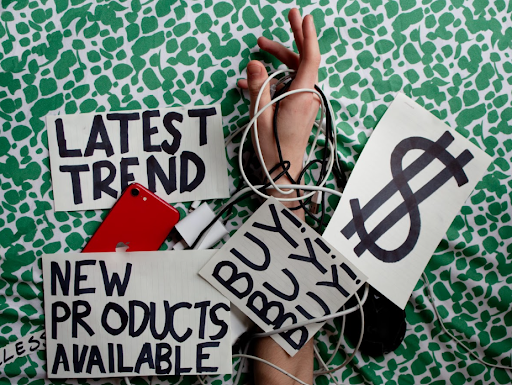In a world where exclusivity drives desire, scarcity is not just a market condition—it’s a carefully orchestrated strategy. Companies like Burberry and Nike have mastered the art of artificial scarcity to not only heighten demand but also elevate their products to symbols of status and prestige. This strategy, while profitable, raises important ethical and environmental questions. Dive into how scarcity shapes both markets and mindsets.
[As a writer at ESSA, and a law and commerce student, Jade has a strong interest in economics, global trends and business ethics. Combining analytical thinking with a passion for understanding market dynamics, she aims to provide insightful and engaging content that explores the intersection of economics and consumer behaviour.]

In 2017, the luxury fashion brand Burberry achieved a revenue of $3.6 billion and destroyed $36.8 million of its own unsold stock. Why would a company destroy their own perfectly good products? The answer can be found in the power of artificial scarcity.
Scarcity has long been a powerful tool in the world of economics, with items perceived as rare or exclusive often experiencing an increase in value. Companies, particularly those in the luxury market, exploit this principle through artificially restricting product availability. Controlled scarcity creates a sense of urgency, commonly triggering impulse purchasing behaviours and heightened demand as consumers rush to buy before it’s “too late”. This trend is constant in the business world, therefore enabling companies like Burberry, Hermès, Nike and Louis Vuitton to maintain high demand at high prices.
Limited Edition Products: The Illusion of Rarity
Companies create artificial scarcity through the limited release of products. Items are deliberately produced in small quantities, driving up prices as demand overpowers supply. The resulting increase in urgency amongst customers further boosts desire and anticipation for the product, allowing the firm to manipulate the price elasticity of demand of items. When customers know that an item is available only in limited quantities, they are more likely to purchase in fear that they will never get another chance, manifesting the popular Gen-Z phenomenon “FOMO” (Fear of missing out). Purchasers are compelled to act fast, with many queuing for hours to purchase products or engage in high-markup resale markets. By keeping prices high and creating artificial scarcity, brands reinforce the notion that their products are valuable and scarce so that they don’t lose aspirational appeal.
This strategy is widely employed. The fashion industry releases limited-time capsule collections, and niche collectible industries like the collectible card company Pokémon, produce restricted stock of products. Sneaker brands like Nike and Adidas collaborate with well-known celebrities or designers to release limited-edition shoes. According to the resale giant Stock-X, Nike resales can experience as much as a 200% surge in resale price immediately after a release. This can be attributed to scarce releases of particular colourways and designs that boost exclusivity and desirability.

Luxury branding: Portraying exclusivity as a status symbol
When Louis Vuitton releases a limited edition bag, it’s not just a product–it’s a symbol of exclusivity. High-end brands like Hermès, Rolex and Ferrari market this exclusivity to be synonymous with prestige. By intentionally only producing a couple of handbags, luxury brands fulfil the psychological satisfaction of customers associated with possessing high-quality goods. Owning a Birkin bag, a Rolex watch or a limited edition Ferrari is not just about the product itself, it also signifies status and wealth that can alter the way an individual interacts and is perceived socially. Product scarcity further cultivates a sense of belonging amongst owners who can afford them, fostering a sense of community and brand loyalty through the formation of an “elite club”.
Many luxury brands make their products even more unattainable and scarce through waiting lists. For instance, Hermès requires customers to develop a relationship with the brand before having the opportunity to buy its highly sought after Birkin bag.
Destroying unsold goods to maintain Artificial Scarcity
It’s rare for luxury brands to implement discount strategies or promotions, as they closely associate price with perceived value, viewing such strategies as devaluing. Unsold inventory is often burnt or shredded to prevent market oversaturation and protect perceived exclusivity and luxury. Global fashion retailer H&M was reported to burn over 12 tons of new, unsold clothing each year since 2013, and luxury jewelry and watch brand Cartier destroyed $563 million worth of watches over a two year period.
If high-end products became widely accessible in location and price, they would attract an audience that may not align with the brand’s elite image, lowering perceived prestige and value which in turn minimises overall demand. Artificial scarcity allows brands to control both the location of products and their price elasticity, enabling them to continually charge higher prices that yield increased profit margins.

An ethical debate
While artificial scarcity is evidently a successful business strategy, it has sparked ethical concerns amongst customers, who label the deliberate reduction of supply when increased demand is possible as manipulative. Disappointment is emboldened when companies choose to destroy usable goods instead of simply making them more accessible to customers, evident in the immense backlash and “boycott” movement against Burberry after their practices of deliberately destroying inventory was revealed in 2018.
Environmentally, burning goods releases carbon dioxide and other gases into the atmosphere. This worsens the impacts of global warming on the health of the planet, its habitats and inhabitants. Destroying products also contributes to waste and unnecessary resource overconsumption.
Moreover, artificial scarcity worsens economic and social inequality. Making products exclusive to wealthy, higher-class consumers widens the socioeconomic gap that largely propels discrimination. This extends to the resale industry, where prices are inflated to unaffordable extremes for the average consumer.
Conclusion
Ultimately, companies utilize artificial scarcity to drive demand, uphold an image of exclusivity and maintain premium pricing. They tap into one’s desire for exclusive products or the psychological need to be seen as elite, amplifying urgency through limited releases. Companies can go to extreme lengths of destroying unsold products to maintain this exclusivity and deficiency. Artificial scarcity continues to be a controversial business strategy in the modern consumer economy.
References
Baxter, E., & Baxter, E. (2023, October 21). Why brands are burning their excess stock. YourLifeChoices. https://www.yourlifechoices.com.au/life/fashion/why-brands-are-burning-their-excess-stock/
Desk, T. O. I. Lifestyle, & ET BrandEquity. (2024, November 13). Why Burberry burns millions of dollars of clothes each year? ETBrandEquity.com. TOI-Online. https://brandequity.economictimes.indiatimes.com/news/business-of-brands/why-burberry-burns-millions-of-dollars-of-clothes-each-year/115241715
Gupta, S. B. V. (2024, March 1). Unveiling the economics of sneaker culture: How Nike masters the art of demand generation. Chanakya-The Finance & Investment Cell, BRAC. https://www.linkedin.com/pulse/unveiling-economics-sneaker-culture-rzmvc/
Lieber, C. (2018, September 17). Why fashion brands destroy billions’ worth of their own merchandise every year. Vox. https://www.vox.com/the-goods/2018/9/17/17852294/fashion-brands-burning-merchandise-burberry-nike-h-and-m
Rauturier, S. (2022, April 21). Why do some fashion burn unsold clothes? Good On You. https://goodonyou.eco/fashion-brands-burn-unsold-clothes/
LSI Wins. (n.d.). Understanding labor market supply and demand [Image]. LSI Wins. https://www.google.com/url?sa=i&url=https%3A%2F%2Flsiwins.com%2Funderstanding-labor-market-supply-and-demand%2F&psig=AOvVaw0vMJ-p20H_5cvgHj47CxSC&ust=1742634622094000&source=images&cd=vfe&opi=89978449&ved=0CBYQjhxqFwoTCNjy_v_pmowDFQAAAAAdAAAAABA9
Register Forum. (n.d.). Consumed by consumerism: The dangerous impact of trends [Image]. Register Forum. https://registerforum.org/20945/opinion/consumed-by-consumerism-the-dangerous-impact-of-trends/
Fashionista in Danger. (n.d.). Fashion vs EU [Image]. Fashionista in Danger. https://www.google.com/url?sa=i&url=https%3A%2F%2Fwww.fashionistaindanger.com%2Ffashion-vs-eu&psig=AOvVaw3MoP7boSCokDnEu5wV_7bk&ust=1742634262138000&source=images&cd=vfe&opi=89978449&ved=2ahUKEwj73c7S6JqMAxXTfvUHHQAQEiMQjhx6BAgAEBo



